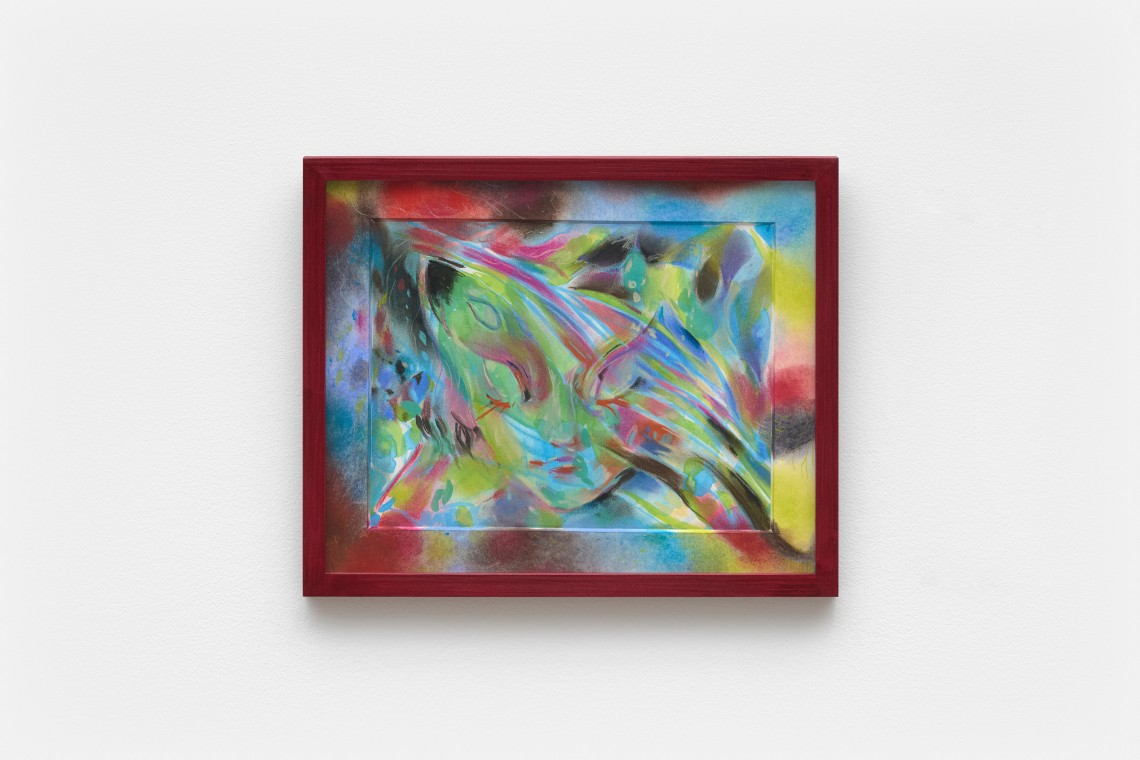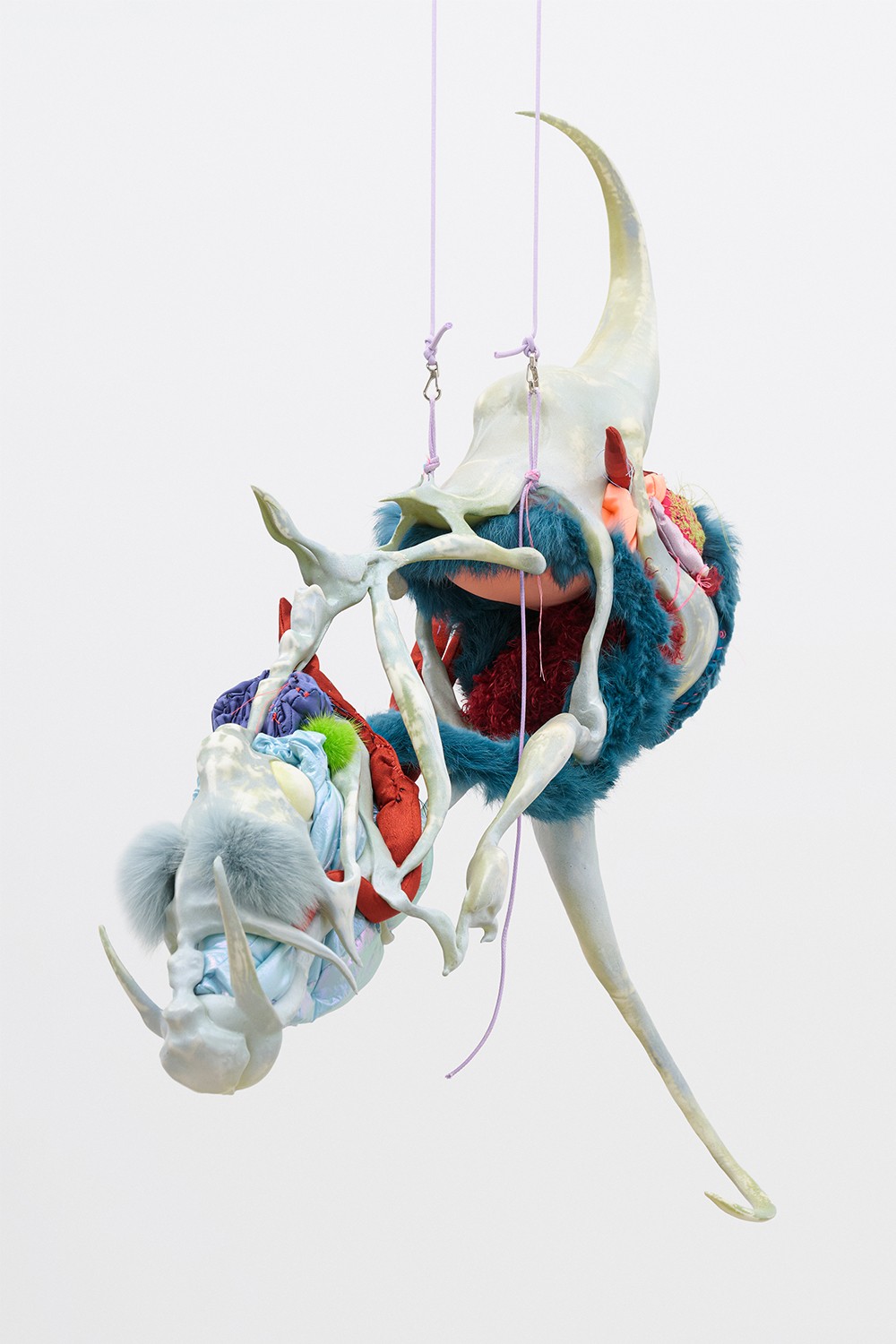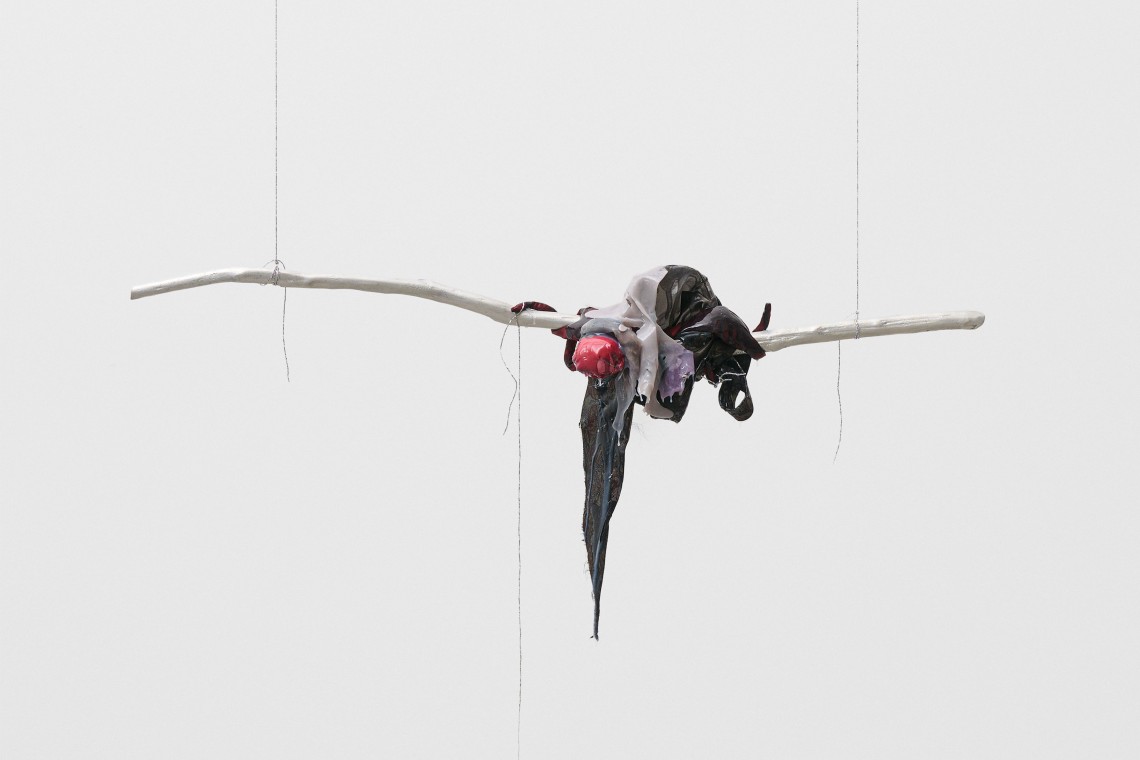Exhibition
POOMSAE
품새

Woo Hannah, Mirror Gazing, 2025, Pastel and gouache on paper and mount, 39.4 x 35.9 cm. Courtesy of the Artist and G Gallery.
Practicing “POOMSAE” to Stand on One’s Own
Park Gahee (Curator)
At times, I find myself imagining the life of a person and wonder where they might be standing at this moment. We are all placed in different circumstances and environments, and accordingly, the shape of our lives and the timing of their transformations appear in various ways. For artists, too, there are inevitably moments of transition across their lifetime, and such changes leave traces in their work. This exhibition, POOMSAE, brings together works created by Woo Hannah during one such transformative period. They embody intense, sorrowful, yet dignified and beautiful moments of life experienced during that time. The title of this exhibition, “POOMSAE,” underwent two changes before arriving at its final form. It was first titled The Self-Destructing Diva, and later, briefly, Demi-Pointe, a term referring to a ballet position. In the short text she shared alongside the title The Self-Destructing Diva, I sensed the artist’s strong will to move forward despite imperfection, and the inner struggle to steady herself on the edge and seek a new balance. Interestingly, the two titles that followed both referenced “postures,” leaving the impression that the artist, through an internal process of accepting change, was ultimately forming a stance to stand firmly on her own two feet. Thus, POOMSAE becomes both an exercise in standing as a person and an artist, and an exhibition that sculpts the idea of independence.
Letting It Out, Without Holding Back
Upon entering the exhibition space, a scene unfolds in which various forms of life and emotion erupt in all directions. The landscape—composed of works from the Bleeding and Milk and Honey series, ongoing since 2023—resembles a storm of raw emotions that seem to resonate across different frequencies, moving toward a state of balance. A body highly reactive to external changes (Cholinergic Bloom, 2025), a figure that enlarges itself to charge forward yet remains vulnerable (Flame thrower, 2025), and a presence where energies of different temperatures are compressed into a single mass (Whispy, 2024)—all these works expand the emotional spectrum from primal outbursts, as seen in the Bleeding series, to more composed restraint. The Milk and Honey series materializes themes of desire and aging in unfiltered forms. A figure that was devoured yet tears its way back out (Half Digest, But Alive, 2024), a character that displays emotional turbulence without reserve, only to blame herself for her immaturity (Mourning Lady, 2024), and a body that slowly mutates in response to external stimuli while retaining a strange beauty (Acid Rain, 2025)—these all articulate a world uniquely shaped by emotional and bodily transformation. Stretching across the gallery floor, veins of silicone and felt appear like lifelines, forming what feels like a physical network connecting the emotions and lives that breathe within the space. These cracks are not gaps to be filled, but marks left by energies bursting through the surface. Colorful fluid spurts boldly like blossoms or stems, visualizing a fierce will to live. The space is filled with remnants of emotions and energies—disgust and love, joy and sorrow, guilt and forgetfulness, despair and sacrifice. By embracing these uncontrollable excretions, the artist brings forth her own world in a new form.
Divas Refigured Through Evolution and Regression
Alongside emotions, bodily transformations are also central to Woo’s practice. After moving through emotional oscillations between self-love and self-loathing, we are met with Walking Diva (2025), a figure standing proudly with an adorned body stretched wide in confidence. These adornments constrain the body like a corset and hinder movement, yet the diva persists, step by step. Born from cycles of collapse and recovery, this diva, as the artist notes, “never stops walking, even as her body frays and falls apart.”¹ The diva reveals the instinct of a body striving to endure uncontrollable emotions and unavoidable realities, trying to grasp fleeting sensations and possibilities. This bodily survival instinct is elevated into a sculptural language, as forms are quietly reorganized in the name of endurance. Surrounding Walking Diva are drawings of transformed bodies. Woo calls this the “Hall of Divas.”² A being whose face has morphed entirely into an ear due to listening too much, one who tries to hide from shame but ends up even more exposed—these entities continuously reshape their forms on the ambiguous edge between evolution and regression. Rather than turning away from harsh realities, Woo chooses to expose her altered self without hesitation. Her determination—to fail boldly and reveal herself unembellished even when values are shaken—is faithfully reflected in her forms.
Standing Up in Irresponsible Forms
In a 2021 interview, while on the topic of sculptures, Woo Hannah spoke of “irresponsible forms” and the “independence of an upright sculpture.”³ The contrast between sculptures that cannot stand, seen as irresponsible forms, and those that stand upright, seen as independent, is symbolic. A sculpture standing up against gravity feels like a projection of the artist’s effort to hold her own as an individual. Yet Woo simultaneously insists on preserving the irresponsible form. This idea is embodied in Lobster (2021). Made of soft, non-self-supporting materials like fabric and stuffing, the sculpture could not stand on its own at the time, and the artist used wire to suspend it in the air. In contrast, she mentioned that if she were to install Lobster in this exhibition, she would like to lay it slack on the floor. This shift acknowledges the physical limits of the material and opens up possibilities for becoming upright by embracing assistance from other materials. This attitude continues in later works. Notably, the artist’s experience learning ballet over the past year has helped her internalize bodily awareness—balance, skeletal alignment, and muscular tension—making her more conscious of and responsive to gravity. Demi-Pointe (2025), born from this experience, materializes the imagination of a new body sprouting from dried stone like hardened feet. Starting from a pose that raises the body from the toes, this sculpture oscillates between balance and imbalance, carefully tuning material and form, connecting bodily practice and sculptural attitude. Here, fabric no longer dominates the core but instead plays a supporting role or flows along the periphery, adopting a more fluid function. The combination of heterogeneous materials collides and cooperates, visually manifesting the shifting tides of emotion within a single work. In this way, Woo Hannah continues to sculpt metaphors of uprightness and independence while embracing the stance of the “irresponsible form”—an assertion of will to rise even in states of collapse, a sculptural conviction to preserve her shape amid softness and fragility.
Poomsae: Sculpting a Stance of Survival
When asked about the music she listens to most, the artist shared about ten tracks.⁴ These pieces commonly build emotional intensity through repeated short rhythms and melodies, alternating between release and tension to create moments of emotional catharsis. The structure of these rhythms naturally recalls the artist’s sculptures—creatures that crawl across the gallery floor, walk, climb the walls, rise from the ground, or find their center and stand. Like divas, moving through despair and hope with a solemn grace, they repeat their own rhythms with poise and persistence. POOMSAE sculpts this stance of survival, unfolding a firm resolve to stand on one’s own. The artist continues practicing her own poomsae—learning how to stand again and again, even in fragile states. Through this, we come to face a new kind of resilience that does not come from solidity. She will continue to walk, following the rhythm of her own making—with grace.

Woo Hannah, Rat Tail Comb, 2025, Lacquer paint, 3D printed PLA, fabric, cotton, string, thread, 62 x 53 x 22 cm. Courtesy of the Artist and G Gallery.
스스로 서기 위한 “POOMSAE 품새” 연습
박가희(기획자)
나는 가끔 한 사람의 생애를 상상하며, 그 사람이 지금 어디쯤 서 있을지 궁금해 하곤 한다. 사람마다 놓인 조건과 환경은 다르고, 그로 인해 삶의 형태와 변화의 시기 또한 각각 다르게 찾아온다. 작가에게도 생애에 걸쳐 전환의 시기가 있기 마련이며, 그러한 변화는 작업 속에 흔적을 남긴다. 이번 전시 《POOMSAE 품새》는 작가 우한나가 바로 그런 생애적 전환의 과정에서 만든 작품들로 구성되었으며, 그 과정에서 겪은 치열하고, 처연하지만 의연한, 생애의 아름다운 순간을 담고 있다. 이번 전시의 제목이 “품새”가 되기까지 두 번의 변화가 있었다. 처음엔 “자멸하는 디바”로, 그 다음엔 잠시 발레의 한 자세를 일컫는 “드미프앙”이라 불렸다. 자멸하는 디바라는 제목과 함께 전달된 작가의 짧은 글에서 나는 불완전함 속에서도 앞으로 나아가려는 작가의 강렬한 의지와 경계 위에서 스스로를 다잡고 새로운 균형을 찾고자 하는 내적 투쟁을 읽을 수 있었다. 흥미롭게도 이후에 등장한 두 제목 모두 ‘자세’를 뜻하는 단어였다는 점은, 작가가 변화의 흐름을 받아들이는 내면의 과정을 거쳐 마침내 자신의 두 발로 서기 위한 태도(자세)를 다져갔다는 인상을 남긴다. 따라서 《POOMSAE 품새》는 인간이자 작가로서 스스로를 세우는 연습이자, 독립을 조형한 전시다.
애써 참지 않고 그대로 뿜어내기
전시장에 들어서면, 시야 가득 다양한 생명과 감정이 사방으로 솟구치는 광경이 펼쳐진다. 2023부터 이어온 〈Bleeding〉과 〈Milk and Honey〉 연작이 혼재하는 이 풍경은 마치 처절한 감정의 파도 속에서 서로 다른 파장을 타고 공명하며 균형을 찾아 움직이는 듯 보인다. 외부의 변화에 예민하게 반응하는 신체(〈콜린성 개화〉, 2025), 몸집을 극대화하며 저돌적으로 나아가지만 연약한 존재(〈화염방사기〉, 2025), 온도가 다른 에너지가 한 덩어리로 응집된 존재(〈위스피〉, 2024)는 모두 〈Bleeding〉 연작에서 드러났던 원초적인 감정의 분출에서 질서 있는 억제까지 확장된 감정의 스펙트럼을 보여준다. 〈Milk and Honey〉 연작들은 욕망과 노화를 거침없는 형태로 구체화한다. 어떤 존재에 먹혔지만 내부에서 그것을 찢고 나오거나(〈살아난 자〉, 2024), 감정의 기복을 여과 없이 드러낸 뒤 미성숙함에 대해 자책하거나(〈지긋지긋한 여자〉, 2024), 외부 자극에 반응해 서서히 변용되면서도 그 속에서 비범한 아름다움을 품은 신체(〈산성비〉, 2025) 등, 이 연작은 감정과 신체의 변형이 맞물린 고유한 세계를 제시한다. 이 모든 존재들이 뿜어져 나온 전시장 바닥에는 실리콘과 펠트로 이루어진 균열이 핏줄(생명선)처럼 뻗어 있다. 이는 마치 이 공간에 숨 쉬는 다양한 생명과 감정의 물리적 연결망을 형성하는 듯하다. 그러니 균열은 메워진 틈이 아니라, 머금은 에너지가 터져 나온 흔적이다. 형형색색의 액체가 꽃처럼, 혹은 줄기처럼 대담하게 솟아오르는 모습은 강렬한 생명의 의지를 형상화한다. 이 공간에는 혐오와 사랑, 기쁨과 슬픔, 자책과 망각, 좌절과 희생 등 다양한 감정과 에너지의 잔상으로 가득 차 있다. 이렇게 뿜어져 나온 참을 수 없는 분비물들을 껴안으며, 작가는 새로운 형태로 자신만의 세계를 틔어낸다.
진화와 퇴화를 오가며 새롭게 조형된 디바들
감정뿐만 아니라, 신체의 변형 역시 작가의 작품 세계를 구성하는 주요한 요소이다. 자기애와 자기혐오 사이를 끊임없이 오가는 감정의 동요를 지나 우리를 마주하는 것은 화려한 장식으로 감싼 몸을 최대한 펼쳐 호기롭게 자신감을 뽐내며 서 있는 〈걸어가는 디바〉(2025)다. 그 장식은 마치 코르셋처럼 몸을 조이며 움직임을 방해하지만, 디바는 기어코 한 걸음 한 걸음을 내디딘다. 자멸과 회복을 반복하는 과정에서 탄생한 디바는 “점점 너덜너덜해지는 몸으로도 끝내 걷기를 멈추지 않는다”고 작가는 말한다.¹ 디바는 제어할 수 없는 감정과 피할 수 없는 현실을 견디며, 스쳐 지나가는 감각과 가능성들을 붙잡으려는 신체의 본능을 드러낸다. 이러한 몸의 생존 감각은 조형 언어로 승화되며, 생존을 위한 형체가 조용히 재구성된다. 〈걸어가는 디바〉의 주변에는 변형된 신체들의 드로잉이 이어진다. 작가는 이들을 일컬어 “디바의 전당”이라 했다.² 듣다가 얼굴 전체가 귀로 변형된 존재, 수치심에 숨고 싶지만 오히려 더욱 드러나 버린 존재 등, 이들은 진화인지 퇴화인지 모호한 경계 위에서 자신들의 형태를 끊임없이 재구성한다. 작가는 직면한 현실을 외면하지 않고, 변형된 자신의 모습을 되려 망설임 없이 드러내는 데에 집중한다. 자신감 있게 망하고, 가치 기준이 흔들리는 순간에도 꾸밈 없이 그대로는 보여주겠다는 작가의 단단한 태도가 고스란히 형태에 반영된다.
책임감 없는 모양으로 일어서기
우한나는 2021년에 진행한 한 인터뷰에서 조각을 말하며 “책임감 없는 모양”과 “직립한 조각의 독립”을 언급한 바 있다.³ 직립하지 못하는 조각을 ‘책임감 없는’ 형태로, 반대로 스스로 일어선 조각을 ‘독립적’이라 표현한 점은 상징적이다. 중력을 거슬러 서 있는 조각은 마치 하나의 존재로서 제 몫을 다하려는 작가 자신에 대한 투영처럼 읽힌다. 그러나 작가는 동시에, 책임감 없는 모양 역시 고수하고자 한다. 그렇게 등장한 작품이 〈랍스터〉(2021)다. 패브릭과 솜 같은 부드럽고 비자립적인 재료를 사용해 만든 이 조각은 직립할 수 없었기에, 당시에 작가는 와이어를 덧대어 공중에 세웠다. 한편, 작가는 이번 전시에 <랍스터>를 설치한다면 바닥에 축 늘어뜨려 놓고싶다고 말했다. 이 과정에서 작가는 재료의 물리적 한계를 인정하고, 다른 물질의 도움을 수용하여 작품이 자립해 서 있는 존재로 나아갈 가능성을 열어두었다. 이후의 작업에서도 이러한 태도는 계속된다. 특히, 지난 일년간 배운 발레의 경험은 무게중심, 뼈의 정렬, 근육의 긴장을 체화하며 중력을 인식하고 활용하는 신체 감각을 익히도록 도왔다. 마치 말라붙은 돌처럼 단단해진 발에서 출발한 〈드미프앙〉(2025)은 발에서 새로운 신체가 자라나는 상상을 구체화한 조형이다. 발끝으로 중심을 잡고 몸을 일으키는 자세에서 출발해, 균형과 불균형 사이를 오가며 재료와 형체를 세심하게 조율하는 이 조각은 신체의 연습과 조형의 태도를 잇는다. 이때, 패브릭은 더 이상 중심을 지배하지 않으며, 가장자리에서 보조적인 역할을 수행하거나 주변을 따라 흐르는 방식으로 유동적인 역할을 한다. 이질적인 재료들의 구성은 충돌하고 함께 작동하며 한 작업 안에서 감정의 파고처럼 출렁이는 감각의 흐름을 시각적으로 구체화한다. 이처럼 우한나는 직립과 독립이라는 인간 존재의 은유를 이어가는 동시에, ‘책임감 없는 모양’이라는 태도를 고수한다. 이는 무너질 듯 위태로운 상태에서도 끝내 자신을 일으켜 세우려는 의지이며, 단단하지 않음 속에서도 자신만의 형체를 지키려는 조형적 신념이다.
품새, 생존의 자세를 조형하기
작가에게 자주 듣는 음악을 묻자, 열 개 남짓의 링크가 돌아왔다.⁴ 공통적으로 이 음악들은 짧은 리듬과 멜로디를 반복하며 점진적으로 긴장을 고조시키고, 해소와 긴장을 교차시키며 강렬한 감정적 고양을 만들어냈다. 이 리듬의 구조는 자연스레 작가의 조각을 떠올리게 했다. 전시장 바닥을 기고, 걷고, 벽을 타고 오르며, 바닥에서 솟아나고, 중심을 잡고 서 있는 존재들. 처연하면서도 의연하게 스스로의 리듬을 반복하며, 절망과 희망 사이를 우아하게 유영하듯 걸어 나아가는 디바들 말이다. 《POOMSAE 품새》는 그런 생존의 자세를 조형하고, 제 스스로를 직립시키는 단단한 결의를 펼쳐 보인다. 작가는 무너지기 쉬운 상태에서도 계속 일어서는 법, 자신만의 품새를 연습한다. 그리고 우리는 단단하지 않음으로부터 비롯된 새로운 강인함을 마주하게 된다. 그는 앞으로도, 스스로의 리듬을 따라 우아하게 걸어 나갈 것이다.

Woo Hannah, The Unswallowable Night, 2025, Aluminum, fabric, stuffing, string, silicone, 47 x 101 x 20 cm. Courtesy of the Artist and G Gallery.
2025. 08. 27. (Wed) – 2025. 09. 27. (Sat)
G Gallery